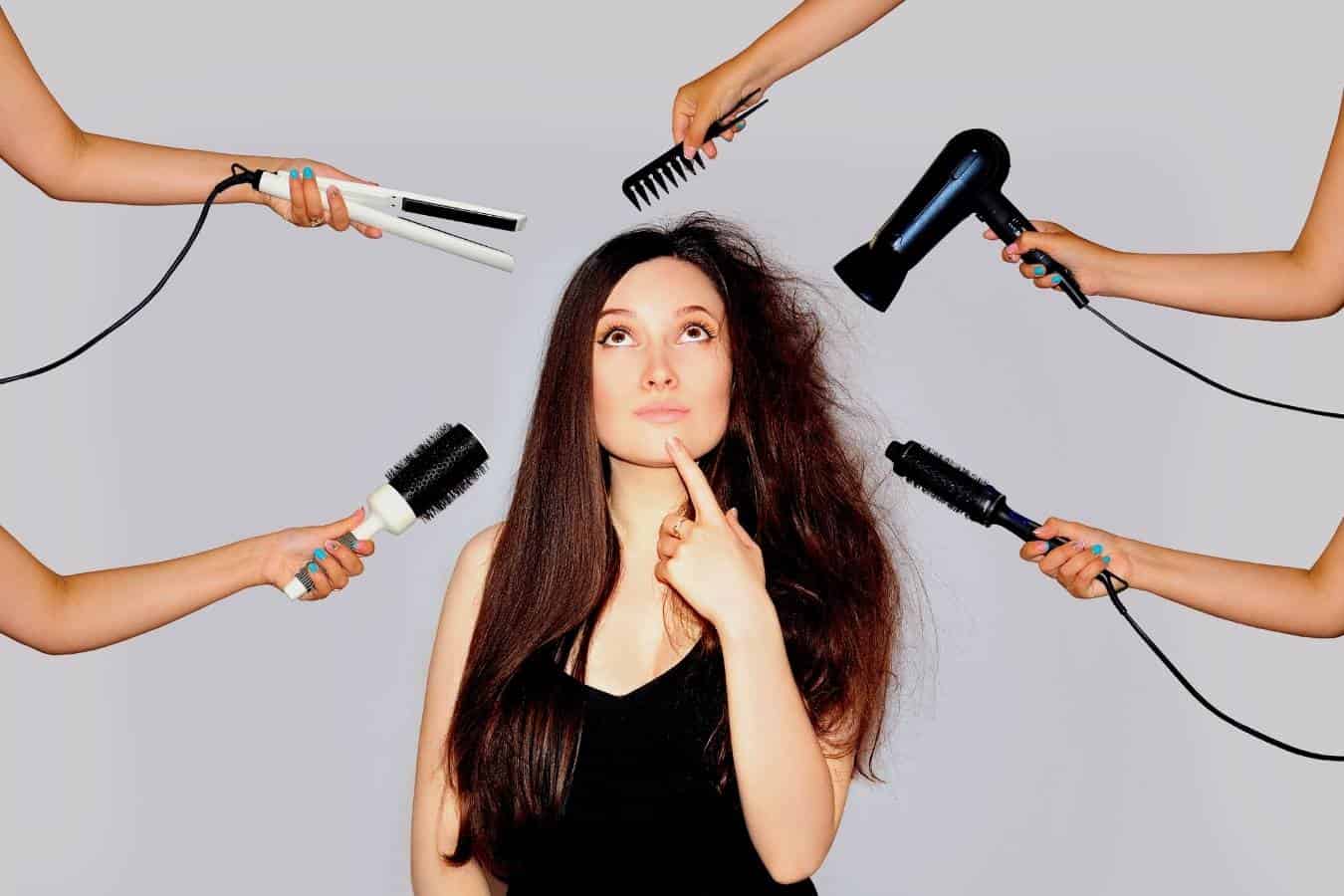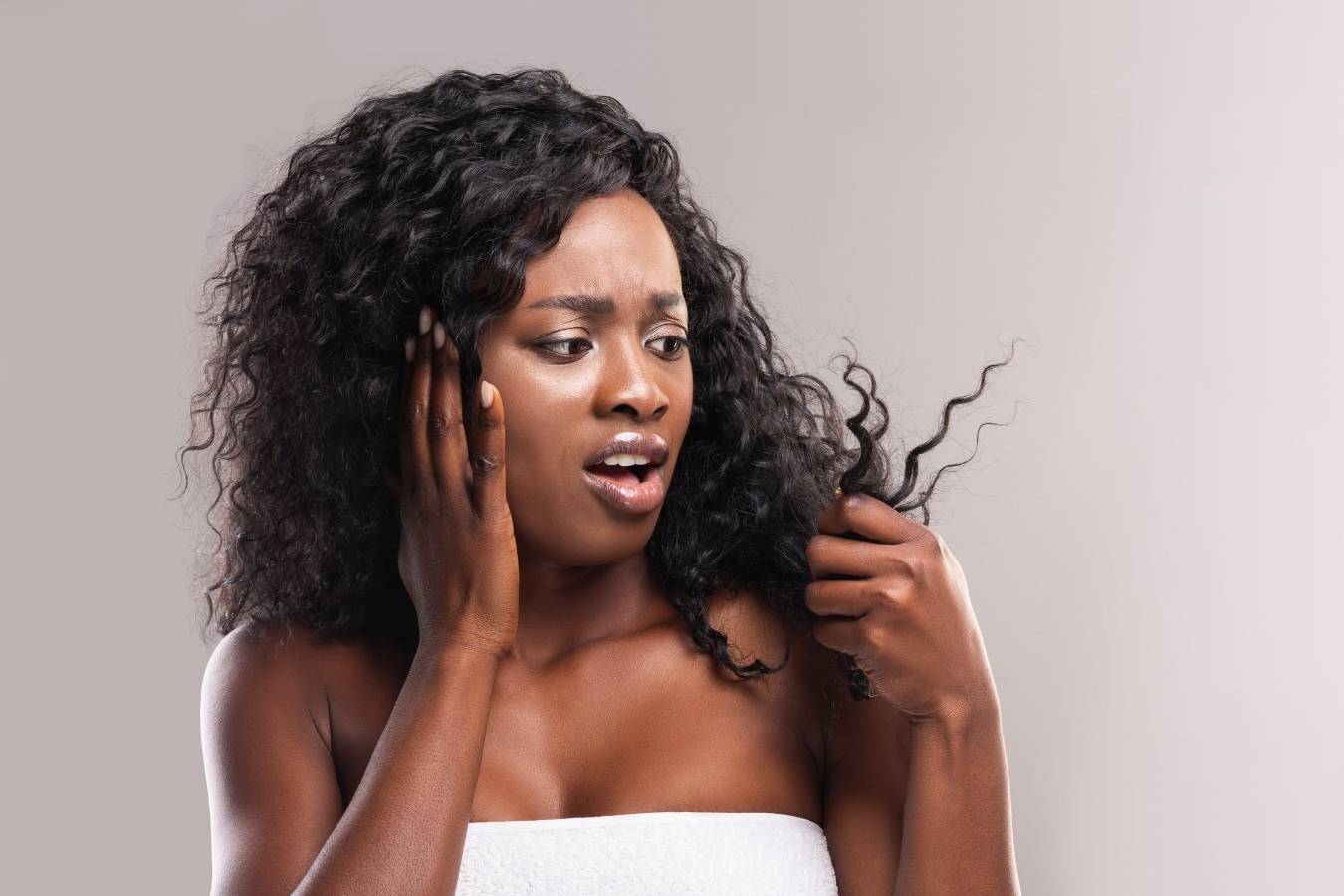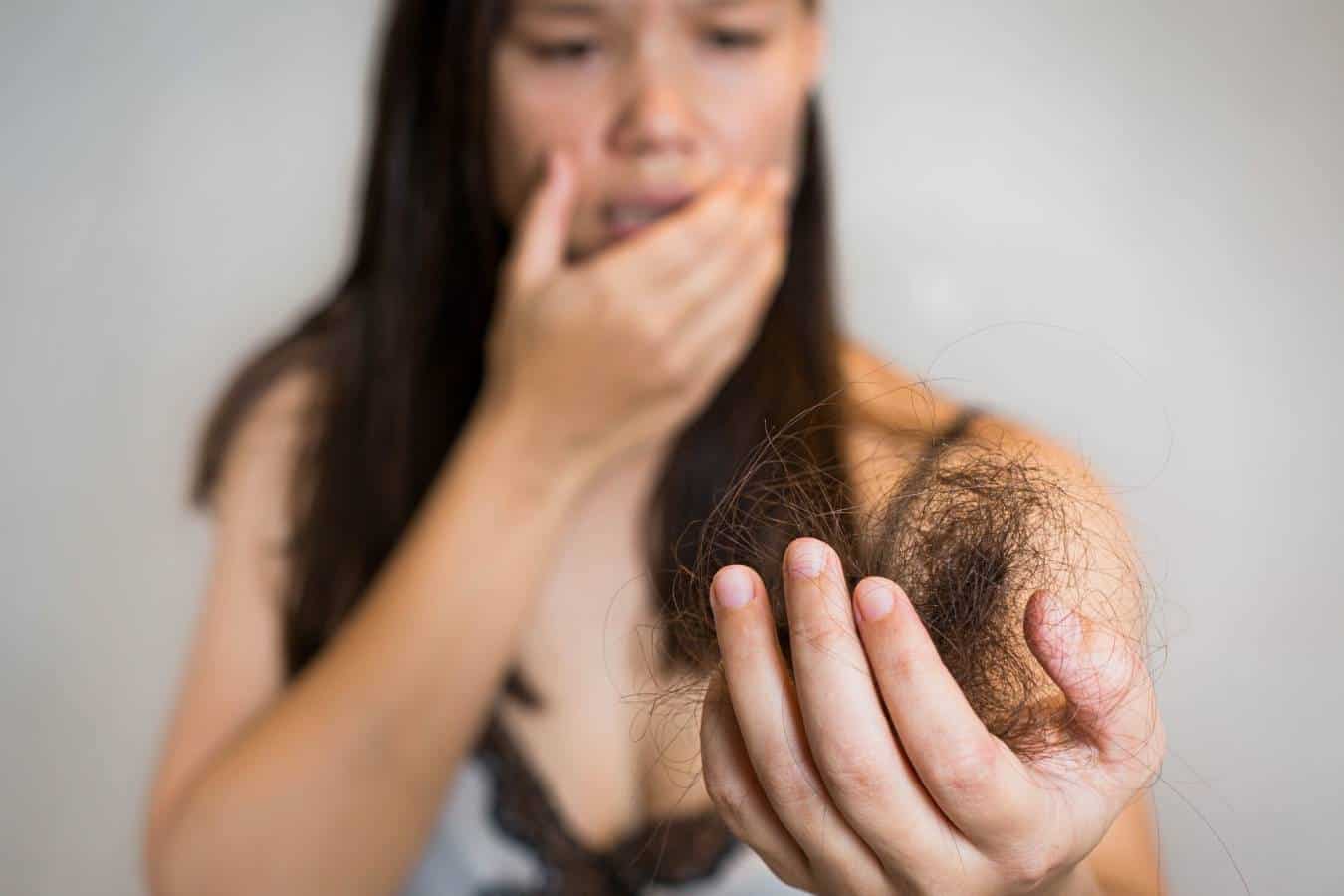Hair chemical treatments such as coloring, relaxing, and perming can make you look good. But they can also lead to dry and damaged hair when used excessively. If you need to repair severely chemically damaged hair, here’s everything you need to know.

There are several ways to repair severely chemically damaged hair. Using hair masks and quality hair products helps to restore the appearance of damaged hair. In most cases, the only way to repair hair with severe chemical damage is by trimming and waiting for healthy, new hair to grow in its place.
This post contains affiliate links and we may earn if you click on them (at no extra cost to you). Please read our full disclosure policy here.
Signs of Severely Chemically Damaged Hair
Wondering whether chemicals have severely damaged your hair? Here are the signs to watch out for:
Your Hair Breaks Easily
When your hair strands get damaged, they tend to develop fractures, so the hair will easily break off at these weak spots.
In addition, overly processed hair lacks elasticity when it’s wet because of protein deficiency, so it snaps easily when pulled.
Hair breakage is one of the most common symptoms of severely chemically damaged hair, and it can be difficult to reverse.
There are Visible Split Ends
A strand of hair is typically made of two or three layers.
The cuticle is the outer layer, and the cortex is the middle layer. The medulla is the inner layer that’s often present in thick hair.
When the cuticle gets damaged, it tends to separate from the cortex, which results in split ends.
Because of the severe damage, the bond between the cortex and cuticle weakens so much that split ends become visible.
Usually, the hair strand will fray at the ends, but the split can happen anywhere along the hair shaft.
Your Hair is Dry and Dull
When your hair feels dry and brittle, it’s a tell-tale sign that the cuticle is damaged.
Keep in mind that the cuticle is composed of overlapping scales that lock in moisture when closed.
Chemical treatments can also strip away the natural oils and moisture that coats the cuticle, so the hair will not only lose its shine but will also feel and look dehydrated.
Your Hair Tangles Easily
Hair that doesn’t have enough moisture locked in will tangle easily.
The problem with chemically damaged hair is that it’s still difficult to detangle even after it’s been conditioned.
Again, this boils down to damaged cuticles that are raised when open.
Damaged cuticles attach to one another easily, so hair strands end up more knotted. This situation is worsened by a lack of moisture.
Your Hair Is Frizzy
Some hair types are naturally frizzy, but flyaway hair can also result from too many chemical treatments.
Frizzy hair is one of the common signs your cuticles are open, which leaves the inner layers exposed.
As a result, your hair will easily absorb moisture from the surroundings.
The hair strands will swell and become misaligned, and individual hair strands will stand up independently or run in multiple directions.
You’ve Noticed Some Hair Loss
Hair loss is one of the most regrettable symptoms of severe chemical damage.
Chemical treatments also affect the scalp’s health because of the way some styling techniques pull on hair roots, damaging hair follicles.
This can lead to permanently thin hair.
Also Read: How To Avoid Poofy Hair After You Straighten It (Top Tips)
Can You Repair Severely Chemically Damaged Hair?

Yes, it’s possible to repair severely chemically damaged hair, but not in the way most people think.
More often than not, the damage is so far gone that the hair needs to be trimmed, so it can be replaced by healthy new hair.
For instance, split ends tend to travel up the hair shaft, weakening the strand further. Therefore, the split needs to be removed to avoid further hair breakage.
The good news is, mildly damaged hair can be repaired using various hair treatment methods.
Some treatments work to close the cuticle, restoring shine and sleekness.
You should note that repairing severe hair damage takes time, so be patient and apply the right hair care treatments consistently.
Also Read: The Best DIY Pre-Poo Recipes For Damaged Hair
How To Repair Severely Chemically Damaged Hair

In most instances, repairing severely chemically damaged hair involves sprucing up the hair’s appearance.
This helps tide you over until the damaged hair can be cut and replaced with brand new locks.
Here’s what you need to do:
1 Trim Split Ends
Book an appointment with your hairstylist and ask them to chop off any dead ends before they cause further damage.
As new, healthy hair grows, the chemical damage will slowly be reversed.
2 Apply Hair Masks
A hair mask has a similar function to your conditioner. However, most hair masks provide more intensive nourishment.
Using a hair mask in place of your everyday conditioner once or twice a week can do wonders for damaged hair.
Wash Your Hair Less Frequently
Shampooing your hair less means your hair retains its natural oils for longer. These natural oils are necessary to combat split hairs and reduce breakage.
3 Use A Leave-in Conditioner
This gives your hair a deep conditioning effect that moisturizes and nourishes.
4 Use Quality Hair Products
Chemically free products can help your hair recover.
These products don’t contain harsh chemicals, such as parabens and sulfates.
5 Avoid Heat Styling
If possible, avoid heat styling your hair. Alternatively, you can apply a heat protector or use the lowest heat settings possible.
When rinsing your hair, use cold water to close the cuticle and strengthen your hair strands.
Reasons Why Your Hair Has Become Damaged
Understanding the reasons behind damaged hair is the first step in repairing the problem and ensuring that you don’t keep damaging your hair.
Let’s look at some common culprits of damaged hair:
Color Treatments
Most hair dyes contain strong chemicals like hydrogen peroxide and ammonia. These weaken the hair shaft, causing hair breakage. In addition, chemical dyes strip away your hair’s natural oils and moisture, so your hair can go from soft and smooth to coarse and brittle.
Bleaching
Bleach has a more damaging effect on hair than dyes because of the high concentration of hydrogen peroxide. The hydrogen peroxide turns darker hair into blonde by removing the melanin responsible for your pigment. Unfortunately, it also removes moisture and elasticity, leaving your hair dry, weak, and prone to breakage.
Heat Styling
While heat tools like blow dryers and curling irons are useful for straightening hair and making it silky smooth, they dehydrate the hair and damage the protein fibers. Applying heat to your hair also opens up the cuticles and promotes split ends.
Not Trimming Your Hair
Even healthy hair needs to be trimmed regularly because of split ends. Split ends can’t be repaired, so they must be removed before they travel up the shaft and ruin the whole strand.
Using The Wrong Hair Products
Do you know what’s in your hair care products? Beware because some shampoos and conditioners on the market contain harsh chemicals, like sulfates, parabens, formaldehyde, and synthetic fragrances and colors. These chemicals can cause severe damage to your hair.
Treatments You Should Consider
Keratin Treatments
This is a top-tier treatment for chemically damaged hair.
Your hair is made up of keratin, and coating your cuticle with keratin protein helps tame frizzy hair.
This can result in straighter and smoother hair that will look good for at least a couple of months.
Bond Building Hair Treatments
Bond building hair treatments are specially formulated to repair damage caused by bleaching and heat styling.
Bond builders help to reconnect broken bonds in chemically processed hair, thereby strengthening it.
Moisture Treatments
Moisture treatments are meant to deeply condition the hair, so it looks shiny. Moisturized hair is also less likely to develop split ends.
The most popular types of moisture treatments involve products that contain oils like coconut oil, jojoba oil, argan oil, and olive oil.
Scalp Treatments
When your hair is severely chemically damaged, it’s a sign that your scalp also needs some TLC.
Generally, scalp treatments are formulated to treat itchy and stressed scalps.
They create a soothing effect that promotes a healthy scalp environment.
Also Read: How to Tame Frizzy Hair Overnight (5 Easy Hacks)
Apple Cider Vinegar Rinse
An apple cider vinegar rinse is an easy DIY treatment that closes the cuticles on damaged hair and creates the right pH balance for the scalp and hair.
5 Best Products to Use for Chemically Damaged Hair
Here’s our recommended list of five products to help you treat hair with severe chemical damage:
1. WOW Apple Cider Vinegar Shampoo and Hair Conditioner
This product can do so much for damaged air. The antimicrobial properties of apple cider vinegar fight dandruff, while the oil ingredients help restore moisture and hydration. As a bonus, it doesn’t contain any parabens, silicones, mineral oils, or sulfates.
2. Keratin Hair Treatment, Hair Mask, Deep Conditioner
Hair masks are very popular, and this keratin-infused mask is designed for dry, damaged, or color-treated hair. It promised to deeply condition hair while restoring the cuticle’s protective shield. Perhaps the best thing about this hair mask is, it works in under a minute, as you only have to massage your hair for 3 seconds before rinsing.
3. Collagen Coating Hair Protein Treatment
Collagen contains amino acids that help repair damaged hair, so this collagen coating protein treatment could be the solution your chemically affected hair needs. Use it after shampooing and then leave for up to 20 minutes. The product works for overprocessed hair of all types and provides an easy way to give your hair some intensive treatment while at home.
4. Hydrating Argan Oil Hair Mask and Deep Conditioner
Argan oil has many benefits for hair. It can repair damaged hair by hydrating and deeply conditioning each strand. This is why this product’s formulation might work for you if you have weak, damaged, and overprocessed hair. Applying this product may leave your hair softer and more manageable.
5. Olaplex Hair Perfector Repairing Treatment
This hair repairing treatment comes with three main benefits to chemically damaged hair. It reduces breakage, repairs damaged hair and restores your hair’s healthy look. It also doesn’t contain any sulfates, parabens, or other harsh chemicals that could cause further damage to your hair.
How To Prevent Hair Damage Caused By Chemical treatments

Remove Split Ends Regularly
You might not like the idea of trimming your hair, but it actually prevents your hair from weakening and breaking.
Split ends need to be stopped in their tracks as soon as they occur.
Protect Your Hair From Harsh Chemicals
You must remember to keep using quality hair products that don’t contain harsh chemicals.
Protect Your Hair From Excessive Heat
Use chemical treatments sparingly.
The longer you spend in-between treatments, the more time your hair has to recover, preventing severe damage.
Go To A Professional Hair Care Expert
Some DIY chemical treatments do more harm than good. It’s best to have a hair care expert handle your hair to minimize the effects of chemical damage.
Eat A Healthier Diet
Studies show that nutrition is closely tied to hair health.
For instance, eating foods rich in protein and good fats can boost hair growth, strength, and thickness.
Disclaimer: This site is not intended to provide professional or medical advice. All of the content on LovedByCurls.com is for informational purposes only. All advice should be followed at your own discretion. Ingredients may change at any time so always check the product label before using. Check our full disclaimer policy here.





